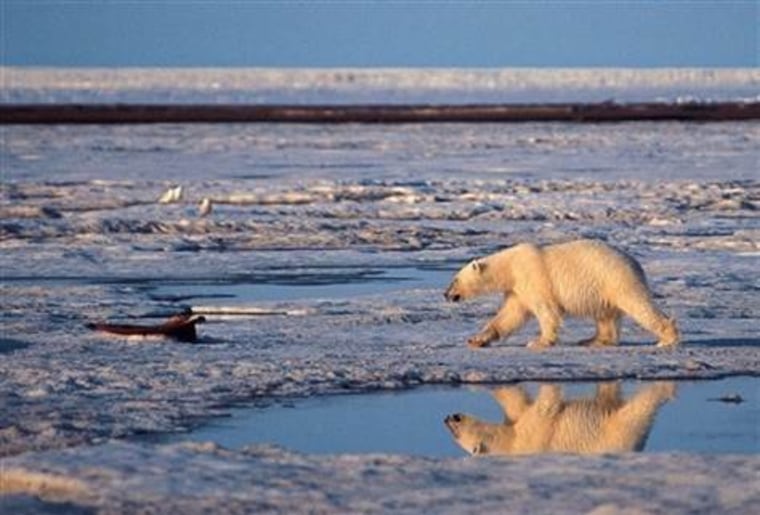Regularly flown-in loads of seal meat could feed hungry polar bears and prevent them from wandering into coastal villages in search of food when they are suddenly unable to find it elsewhere due to global warming, according to the world’s top polar bear scientists.
Currently, however, no such plan exists in any of the five nations with jurisdiction over the globally threatened species, the researchers warn in a new paper. And that’s a problem, given that just one exceptionally early breakup of sea ice could leave a large number of bears starving.
"The modeling work we’ve done indicates that we are going to see these critical events in the next decades," Andrew Derocher, a polar bear biologist at the University of Alberta, told NBC News.
Loss of sea ice
Polar bears rely on sea ice platforms to hunt their favored prey: ringed seals. When the ice breaks up due to warmer temperatures, polar bears retreat inland and fast until the ice refreezes in the fall.
The widespread loss of sea ice in the Arctic, along with changes in breakup and refreeze times, has already resulted in weakened polar bear populations, Derocher and colleagues note in the journal Conservation Letters. And these changes are expected to continue.
"Given the amount of inertia in the climate system, it is very clear that we are going to lose polar bear populations," Derocher said, citing research that indicates two-thirds of the bears will be gone by 2050, mostly at lower latitudes.
The question is how to manage this decline. If a so-called crisis year hits, should the starving bears be left to die or should money be spent (and if so, how much) trying to save them, hoping that the next year the sea ice will stay intact long enough for the bears to survive on their own?
Intervention feeding could keep some bear populations around for another 10 to 20 years, long enough to maintain vibrant polar bear tourism operations, as well as provide a source of subsistence food for Inuit populations, Derocher explained.
Management options outlined in the paper range from doing nothing "to calling out plane loads or helicopter loads of bear chow to try to keep the population alive," he said.
Ultimately, even flown-in food may be insufficient for some populations, assuming climate trends continue. That could mean moving low-latitude bears further north and putting more bears in zoos to preserve genetic diversity so that when the ice returns, a healthy polar bear population can be restored.
"The problem for polar bears is that we might be talking hundreds or thousands of years before sea ice actually comes back in the full context of what we have today," Derocher said.
Options on the table
He stressed that the paper doesn’t say what government wildlife managers should do, but rather lays out options for policymakers to consider. If an early breakup of sea ice were to hit in Canada this summer, for example, it would be illegal to feed any bears in a national park.
"In some cases, it is going to take changes in legislation," he said, an indication that drawing up plans will take time.
Kassie Siegal is the climate program director for the Center for Biological Diversity, a U.S.-based environmental group that pushed the government to list polar bears under the Endangered Species Act and take action to protect them.
She told NBC News that the new study outlines the issues that governments need to consider now to prepare for a crisis event. But, she said, that planning shouldn’t take the focus away from reducing the greenhouse gas emissions at the root of human-caused climate change.
"We still need to do everything we can to cut greenhouse gas pollution," she said. "And we need to look at what we can do to save bears in the wild because we only have so many wild bears and once they are gone, they are gone."
John Roach is a contributing writer for NBC News. To learn more about him, check out his website.
